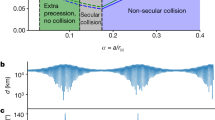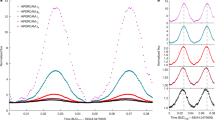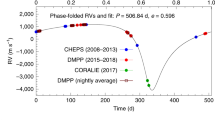Abstract
The recent discovery1,2 of a binary asteroid during a spacecraft fly-by generated keen interest, because the orbital parameters of binaries can provide measures of the masses, and mutual eclipses could allow us to determine individual sizes and bulk densities. Several binary near-Earth3,4,5, main-belt6,7,8,9,10 and Trojan11 asteroids have subsequently been discovered. The Kuiper belt—the region of space extending from Neptune (at 30 astronomical units) to well over 100 AU and believed to be the source of new short-period comets12—has become a fascinating new window onto the formation of our Solar System since the first member object, not counting Pluto, was discovered in 1992 (ref. 13). Here we report that the Kuiper-belt object 1998 WW31 is binary with a highly eccentric orbit (eccentricity e ≈ 0.8) and a long period (about 570 days), very different from the Pluto/Charon system, which was hitherto the only previously known binary in the Kuiper belt. Assuming a density in the range of 1 to 2 g cm-3, the albedo of the binary components is between 0.05 and 0.08, close to the value of 0.04 generally assumed for Kuiper-belt objects.
This is a preview of subscription content, access via your institution
Access options
Subscribe to this journal
Receive 51 print issues and online access
$199.00 per year
only $3.90 per issue
Buy this article
- Purchase on Springer Link
- Instant access to full article PDF
Prices may be subject to local taxes which are calculated during checkout



Similar content being viewed by others
References
Chapman, C. R. et al. Discovery and physical properties of Dactyl, a satellite of asteroid 243 Ida. Nature 374, 783–785 (1995).
Belton, M. J. S. et al. The discovery and orbit of 1993 (243)1 Dactyl. Icarus 120, 185–199 (1995).
Margot, J. L. et al. Satellites of minor planets. IAU Circ. 7503 (2000).
Benner, L. A. M. et al. 1999_KW4. IAU Circ. 7632 (2001).
Nolan, M. C. et al. 2000_UG11. IAU Circ. 7632 (2000).
Merline, W. J. et al. Discovery of a moon orbiting the asteroid 45 Eugenia. Nature 401, 565–567 (1999).
Merline, W. J. et al. Discovery of companions to asteroids 762 Pulcova and 90 Antiope by direct imaging. DPS Meeting 32, abstr. no. 13.06 (American Astronomical Society, 2000).
Brown, M. E. & Margot, J. L. S/2001 (87) 1. IAU Circ. 7588 (2001).
Merline, W. J. et al.; Margot, J. L. & Brown, M. E. S/2001 (22) 1. IAU Circ. 7703 (2001).
Merline, W. J. et al. S/2002 (3749) 1. IAU Circ. 7827 (2002).
Merline, W. J. et al. S/2001 (617) 1. IAU Circ. 7741 (2001).
Duncan, M., Quinn, T. & Tremaine, S. The origin of short-period comets. Astrophys. J. 328, L69–L73 (1988).
Jewitt, D. C. & Luu, J. X. 1992 QB1. IAU Circ. 5611 (1992).
Millis, R. L. et al. 1998 WW31. Minor Planet Electron. Circ. 1999-B24 (2001).
Veillet, C. et al. 1998 WW31. Minor Planet Electron. Circ. 2001-G29 (2001).
Holtzman, J. et al. The performance and calibration of WFPC2 on the Hubble Space Telescope. Publ. Astron. Soc. Pacif. 107, 156–178 (1995).
Image Reduction and Analysis Facility. 〈http://iraf.noao.edu〉.
Tholen, D. J. & Buie, M. W. The orbit of Charon. Icarus 125, 245–260 (1997).
Jewitt, D., Aussel, H. & Evans, A. The size and albedo of the Kuiper-belt object (20000) Varuna. Nature 411, 446–447 (2001).
Elliot, J. L., Kern, S. D., Osip, D. J. & Burles, S. M. 2001 QT_297. IAU Circ. 7733 (2001).
Kavelaars, J. J. et al. 2001 WQ_322. IAU Circ. 7749 (2001).
Trujillo, C. A. & Brown, M. E. 1999 TC_36. IAU Circ. 7787 (2001).
Brown, M. E. & Trujillo, C. A. (26308) 1998 SM_165. IAU Circ. 7807 (2001).
Noll, K. et al. 1997 CQ_29. IAU Circ. 7824 (2002).
Noll, K. et al. 2000 CF_105. IAU Circ. 7857 (2002).
Acknowledgements
C.V., A.D., D.J.T. and M.C. are visiting astronomers at the Canada-France-Hawaii Telescope (CFHT), operated by the National Research Council of Canada, the Centre National de la Recherche Scientifique of France and the University of Hawaii. J.Wm.P. and M.B. are visiting astronomers at the Kitt Peak National Observatory, National Optical Astronomy Observatory, which is operated by the Association of Universities for Research in Astronomy, Inc. (AURA) under cooperative agreement with the National Science Foundation. This work, supported by funding from NASA, is partly based on observations made with the NASA/ESA Hubble Space Telescope, obtained at the Space Telescope Science Institute, which is operated by AURA under a NASA contract.
Author information
Authors and Affiliations
Corresponding author
Ethics declarations
Competing interests
The authors declare that they have no competing financial interests
Rights and permissions
About this article
Cite this article
Veillet, C., Parker, J., Griffin, I. et al. The binary Kuiper-belt object 1998 WW31. Nature 416, 711–713 (2002). https://doi.org/10.1038/416711a
Received:
Accepted:
Issue Date:
DOI: https://doi.org/10.1038/416711a
This article is cited by
-
The wide-binary origin of (2014) MU69-like Kuiper belt contact binaries
Nature (2020)
-
The Hill stability of low mass binaries in hierarchical triple systems
Celestial Mechanics and Dynamical Astronomy (2010)
-
A low density of 0.8 g cm-3 for the Trojan binary asteroid 617 Patroclus
Nature (2006)
-
The formation of Kuiper-belt binaries through exchange reactions
Nature (2004)
-
Worlds of mutual motion
Nature (2002)
Comments
By submitting a comment you agree to abide by our Terms and Community Guidelines. If you find something abusive or that does not comply with our terms or guidelines please flag it as inappropriate.



